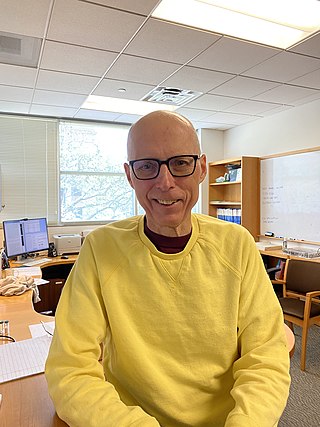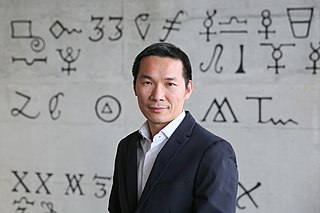
Catalysis is the increase in rate of a chemical reaction due to an added substance known as a catalyst. Catalysts are not consumed by the reaction and remain unchanged after it. If the reaction is rapid and the catalyst recycles quickly, very small amounts of catalyst often suffice; mixing, surface area, and temperature are important factors in reaction rate. Catalysts generally react with one or more reactants to form intermediates that subsequently give the final reaction product, in the process of regenerating the catalyst.

Organometallic chemistry is the study of organometallic compounds, chemical compounds containing at least one chemical bond between a carbon atom of an organic molecule and a metal, including alkali, alkaline earth, and transition metals, and sometimes broadened to include metalloids like boron, silicon, and selenium, as well. Aside from bonds to organyl fragments or molecules, bonds to 'inorganic' carbon, like carbon monoxide, cyanide, or carbide, are generally considered to be organometallic as well. Some related compounds such as transition metal hydrides and metal phosphine complexes are often included in discussions of organometallic compounds, though strictly speaking, they are not necessarily organometallic. The related but distinct term "metalorganic compound" refers to metal-containing compounds lacking direct metal-carbon bonds but which contain organic ligands. Metal β-diketonates, alkoxides, dialkylamides, and metal phosphine complexes are representative members of this class. The field of organometallic chemistry combines aspects of traditional inorganic and organic chemistry.
Nanomaterial-based catalysts are usually heterogeneous catalysts broken up into metal nanoparticles in order to enhance the catalytic process. Metal nanoparticles have high surface area, which can increase catalytic activity. Nanoparticle catalysts can be easily separated and recycled. They are typically used under mild conditions to prevent decomposition of the nanoparticles.

Paul Hugh Emmett was an American chemist best known for his pioneering work in the field of catalysis and for his work on the Manhattan Project during World War II. He spearheaded the research to separate isotopes of uranium and to develop a corrosive uranium gas. Emmett also made significant contributions to BET Theory which explains the relationship between surface area and gas adsorption. He served on the faculty of Johns Hopkins University for 23 years throughout his scientific career.
Tobin Jay Marks is an inorganic chemistry Professor, the Vladimir N. Ipatieff Professor of Catalytic Chemistry, Professor of Material Science and Engineering, Professor of Chemical and Biological Engineering, and Professor of Applied Physics at Northwestern University in Evanston, Illinois. Among the themes of his research are synthetic organo-f-element and early-transition metal organometallic chemistry, polymer chemistry, materials chemistry, homogeneous and heterogeneous catalysis, molecule-based photonic materials, superconductivity, metal-organic chemical vapor deposition, and biological aspects of transition metal chemistry.
Organometallics is a biweekly journal published by the American Chemical Society. Its area of focus is organometallic and organometalloid chemistry. This peer-reviewed journal has an impact factor of 3.837 as reported by the 2021 Journal Citation Reports by Thomson Reuters.
In organic chemistry, a cross-coupling reaction is a reaction where two different fragments are joined. Cross-couplings are a subset of the more general coupling reactions. Often cross-coupling reactions require metal catalysts. One important reaction type is this:

Organocobalt chemistry is the chemistry of organometallic compounds containing a carbon to cobalt chemical bond. Organocobalt compounds are involved in several organic reactions and the important biomolecule vitamin B12 has a cobalt-carbon bond. Many organocobalt compounds exhibit useful catalytic properties, the preeminent example being dicobalt octacarbonyl.
Marcetta York Darensbourg is an American inorganic chemist. She is a Distinguished Professor of Chemistry at Texas A&M University. Her current work focuses on iron hydrogenases and iron nitrosyl complexes.
Melanie Sarah Sanford is an American chemist, currently the Moses Gomberg Distinguished University Professor of Chemistry and Arthur F. Thurnau Professor of Chemistry at the University of Michigan. She is a Fellow for the American Association for the Advancement of Science, and was elected a member of the National Academy of Sciences and the American Academy of Arts and Sciences in 2016. She has served as an executive editor of the Journal of the American Chemical Society since 2021, having been an associate editor of the since 2014.

A metal-phosphine complex is a coordination complex containing one or more phosphine ligands. Almost always, the phosphine is an organophosphine of the type R3P (R = alkyl, aryl). Metal phosphine complexes are useful in homogeneous catalysis. Prominent examples of metal phosphine complexes include Wilkinson's catalyst (Rh(PPh3)3Cl), Grubbs' catalyst, and tetrakis(triphenylphosphine)palladium(0).
Diiminopyridines are a class of diimine ligands. They featuring a pyridine nucleus with imine sidearms appended to the 2,6–positions. The three nitrogen centres bind metals in a tridentate fashion, forming pincer complexes. Diiminopyridines are notable as non-innocent ligand that can assume more than one oxidation state. Complexes of DIPs participate in a range of chemical reactions, including ethylene polymerization, hydrosilylation, and hydrogenation.
R. Tom Baker is an inorganic chemist known for the development and application of inorganic transition metal-based catalysis.
Clark Landis is an American chemist, whose research focuses on organic and inorganic chemistry. He is currently a Professor of Chemistry at the University of Wisconsin–Madison. He was awarded the ACS Award in Organometallic Chemistry in 2010, and is a fellow of the American Chemical Society and the American Association for the Advancement of Science.
Janis Louie is a Chemistry professor and Henry Eyring Fellow at The University of Utah. Louie contributes to the chemistry world with her research in inorganic, organic, and polymer chemistry.
Cathleen M. Crudden is a Canadian chemist. She is a Canada Research Chair in Metal Organic Chemistry at Queen's University at Kingston. In February 2021, she took up the role of Editor-in-chief at ACS Catalysis.

John A. Gladysz, an organometallic chemist, is a Distinguished Professor and holds the Dow Chair in Chemical Invention at Texas A&M University. Professor Gladysz is a native of the Kalamazoo, Michigan area. He obtained his B.S. degree from the University of Michigan (1971) and his Ph.D. degree from Stanford University (1974). He subsequently held faculty positions at UCLA (1974-1982) and the University of Utah (1982-1998). He then accepted the Chair of Organic Chemistry at the University of Erlangen-Nuremberg in Germany. In 2008, he returned to North America as a distinguished professor and holder of the Dow Chair in Chemical Invention at Texas A&M University.

Xile Hu is a Swiss chemist specialized in catalysis. He is a professor in chemistry at EPFL and leads the Laboratory of Inorganic Synthesis and Catalysis at the School of Basic Sciences.
Suzanne Cathleen Bart an American chemist who is a professor of inorganic chemistry at Purdue University. Her group's research focuses on actinide organometallic chemistry, and especially the characterization of low-valent organouranium complexes, actinide complexes with redox-active ligands, and discovery of new reactions that utilize these compounds. Bart's research has applications in the development of carbon-neutral fuel sources and the remediation of polluted sites.

Viktoria Däschlein-Gessner is a German chemist who is the Chair of Inorganic Chemistry II at Ruhr University Bochum. Her research considers organometallic chemistry and catalysis. She has developed ylidic ligands to stabilise reactive main group compounds.








